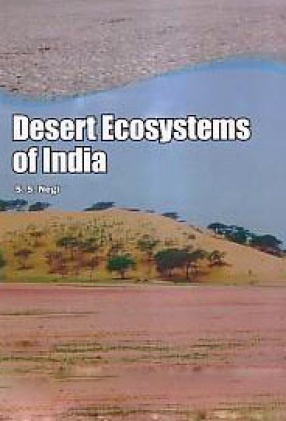
S.S. Negi

41 books




















This book describes the desert ecosystems of the three desert regions of India and their peripheral tracts. These are the Thar desert; Rann of Kutch and the Cold desert regions. It includes forests and grassland ecosystems; fauna and protected areas. Managing desert ecosystems of India forms the last chapter of this book. It will be useful for the ecologist, naturalist, scientist, student, traveler and even the layman.
Contents: Preface. 1. Deserts of India. 2. ...

This book provides a description of the mountain ecosystems of India, including that of the Himalayan range, Western and Eastern ghats, Aravalli, Vindhyan, Satpura mountains and the hills of north-east India. It covers climate soils land use, flora, fauna forests and grassland ecosystems, wet land ecosystems and protected areas.
It is a handy book for the scientist student researcher naturalist and the lay man.
Contents: Preface. 1. Mountains of India and ...

Botany is a basic biological science that deals with the study of plants while forest botany is that branch of botany which covers the study of plants found in forests. India has rich and diverse forests whose study started with botanical explorations that were undertaken way back from the seventeenth century onwards. Knowledge of forest botany is as much relevant today as it was many centuries ago when forests began to be visited by scientists to unravel various ...


This hand book gives basic information about climate change science, including climate; climate change and global warming; air pollution, pollutants and emissions; carbon cycle and carbon sequestration; forests and climate change; agriculture and climate change; United Nations Framework Convention on Climate Change and Kyoto protocol; Intergovernmental Panel on Climate Change (IPCC); Land use, Landuse change and Forestry (LULUCF); Vulnerability, Adaptation and ...

Stretching from the great bend of the Indus River in the north-west to the bend of the Brahmaputra river in the east, the Himalayan Mountain chain is the world's most magnificent Physical feature on the Face of the earth.The Himalayan mountain chain is made up of countless peaks, valleys, rivers, streams, lakes, and glaciers. Some of the most important Rivers of Southeast Asia drain the Himalaya. These include the Indus, the Ganga and the Brahmaputra river ...



Scientific forestry in India began more than 150 years back. At the time of independence, forestry was in a state of flux as the condition of India's forests was poor due to over-exploitation during the two world wars. Soon after 1947, priorities changed and forestry began to play a more direct role in the rural and socio-economic development of the country. This book traces the state of forestry in India from 1947 to 1997. It has been written during the golden ...

Over 2000 species of trees are found in India, of which about 150 are of silvicultural importance. These include teak, sal, sisham, chir pine, deodar, rosewood, sandal wood, eucalyptus, poplars, dipterocarps, khair, babul. This book is a part of several volumes on Indian tress and their silviculture. Only trees of silvicultural, commercial and indigenous importance have been covered. It incorporates the silviculture of leguminous trees belonging to the family ...

This book deals with important trees of India belonging to the family Dipterocarpaceae and their silviculture. Amongst them are trees belonging to the genera Anisoptera, Balanocarpus, Dipterocarpus, Hopea, Shorea, Vateria and Vatica. The silviculture of 25 trees belonging to this family has been discussed in detail. It includes general description; locality factors; phenology; germination and seedlings; silvicultural characters; natural and artificial ...


The appointment of Sir Dietrich Brandis as the first Inspector General of Forests in 1864 is seen as the begining of scientific forestry in India though forestry activities had begun in some provinces in the early part of the nineteenth century. In those days forests were taken only as a source of revenue. Over the last 150 years, there has been a major transformation in the forestry prespective of India. Today, their indispensable role in survival of the human ...



Participatory Integrated Watershed Development is now seen as the optimum approach for Natural Resource development. This book deals with the subject matter of participatory Integrated Watershed Development. It includes chapters on land use; soil conservation; Forestry; Agriculture; Horticulture; Watershed management and participatory processes.


The world has rich forests varying from rain forests to dry thorn scrub and alpine pastures. Human beings depend heavily on forest products in their everyday lives these products include timber and non timber forest products like medicines, drugs, food, fodder, fuel, dyes, tans, essential oils, fibers, flosses, coir, silk, lac, gums, resins and many other products. Forest products are also raw materials for the industrial production of many useful materials like ...


The Himalayan mountain system supports rich and diverse forests and grasslands, which are also the home for a varied assemblage of wild animals. Forests and grasslands play an important role in the lives of the millions of people living in this mountain range and also in the plains of the Indian sub-continent. Wild animals too are vital for the stability of the Himalayan eco-system, thereby enabling it to maintain the delicate environmental balance. Thus, ...



Teak is the most important commercial tree species of south and south-east Asia. In India, it occurs naturally from the eastern parts of 'Rajasthan in the west to Kerala in the south and Tripura in the north central and eastern parts of the country. Teak has also been widely planted both within and outside its home range. At present, vast areas are being brought under commercial teak plantations. However concise, readily readable information in the form of short ...
